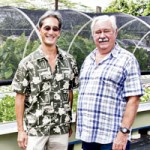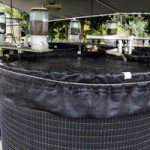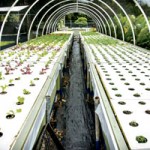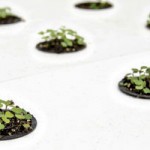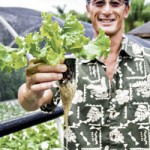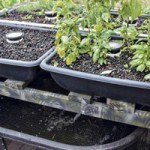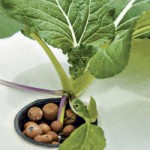A Growing Trend In Aquaponics
“Most of the soil on Kaua‘i is junk,” says Glenn Hontz, program coordinator for advanced education and training in agriculture and business programs at Kaua‘i Community College. “It’s not because of the plantations either. You can blame it on the sun, the rain and the incredible amount of heat that the soil is exposed to all the time.
“That soil can be built back up within a few months,” Hontz continues. “But it’s a lot of work. It’s easier to build an aquaponics facility.”
Bernie Tsao launched the Aquaculture Technology Training program at the University of Nations, Kona, where he was the director for 11 years. Today, he is the Aquaculture and Aquaponics instructor at KCC, and provides consultation services to the community, including the Hyatt, which is considering implementing its own aqua-culture system.
“Aquaponics is a combination of two technologies,” says Tsao, a lithe and energetic man. “It’s aquaculture, or fish farming, and hydro-ponics, a technology that enables people to grow plants without soil.”
Most simply put, plant-filled plastic tubs are placed on top of fish tanks. The fish effluence is turned into nitrate by naturally occurring microbes. Nitrate feeds the plants. The plants grow two to three times faster than those in the ground.
“Combining the two technologies creates a perfect marriage,” says Tsao. “It’s a bio-integrated system. The fish feed the plants, and the plants clean and filter the water, which is pumped back to the fish.”
At KCC, tilapia fish live in 4,500-gallon tanks and are automatically fed six times a day, every two hours. A rainwater catchment system replaces water that is absorbed by the plants or evaporated. Two rows of 48-inch-long, 4-foot-wide beds produce 200 heads of vegetables every week — vegetables that students sell at the Saturday KCC farmers market alongside their traditionally grown brethren.
KCC aquaponics students have successfully grown and sold watercress, lettuce, red and green cabbage, heirloom tomatoes, radishes, beets, red Russian kale, curly kale, oregano, basil, cilantro, Swiss chard, bush beans, bok choi, choi sum, joi choi, kai chou, green onions and chives.
The Brix test, named for professor A. F. W. Brix, a 19th century German chemist, measures plant nutrition and quality.
“The Brix test found that our aquaponics were equal to organically grown,” says KCC worm composting instructor Bobby Burns. “In some cases, vegetables like our beetroot had a higher nutrition level than organically grown.”
Burns was featured in a TED video that you can watch on YouTube by searching for “Bobby Burns: Saving the World Through Global Worming: The Way of the Worm Warrior.”
Aquaponic systems range from large commercial units to setups that will feed a family of four. The mini residential systems cost about $750 to install, and use just $15.12 of electricity a month.
“You can grow a maximum of 96 heads in four weeks,” says Tsao of the residential system. “Assuming a head of lettuce sells for $2 a head, that’s $192. That will pay for the power usage 12.7 times over every month!”
In 2009, Environmental Hawai‘i published an article written by Patricia Tummons called “Food Self-Sufficiency In Hawai‘i Ever More Difficult, Ever More Urgent.” In it, she writes:
“A modest substitution of 10 percent food imports by local products would inject $3.1 billion into the state’s economy and generate at least $6 million in state tax revenues.”
“If you want to change the world, who would you change first?” Tsao asks. “If you take responsibility for your own family and grow enough food for yourself, then we’re on our way to sustainability.”
Farmers markets are an excellent way to support the local economy, but if you’d like to grow your own fish and vegetables, check out KCC’s Aquaponic Workshop. The next one starts Aug. 18, costs $225 and runs for eight weeks.
To register, call 245-8318. For aquaponics information, call Bernie Tsao at 647-0828.
Marta Lane is a freelance food writer. For more information, visit TastingKauai.com.
- Bernie Tsao and Glenn Hontz. Daniel Lane photos
- Tilapia live in 4,500-gallon tanks
- Two rows produce 200 heads of vegetables every week
- Out of the seed trays and into the aquaponics system
- Bernie Tsao sells ‘live’ lettuce at the KCC farmers market. Daniel Lane photos
- This bed filters solid waste
- A residential system
- Growing twice as fast

